Click On Image
For Full Size | Size |
Image Description |
Source
By |
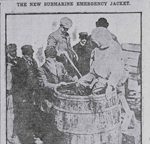 |
1.14k |
THE NEW SUBMARINE EMERGENCY JACKET. |
Image and text provided by University of Utah, Marriott Library.
Photo by The Ogden Standard. (Ogden City, Utah) 1902-1910, 13 January 1909, Image 8, courtesy of chroniclingamerica.loc.gov. |
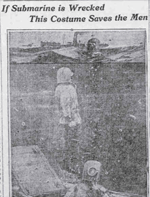 |
533k |
If Submarine is Wrecked This Costume Saves the Men. |
Image and text provided by Arizona State Library, Archives and Public Records; Phoenix, AZ.
Photo by Bisbee Daily Review. (Bisbee, Ariz.) 1901-1971, 11 February 1911, Image 1, courtesy of chroniclingamerica.loc.gov.
|
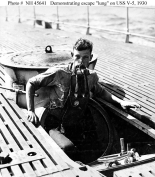 |
104k |
Crewman A.L. Rosenkotter of V-5 (SC-1) demonstrates the use of the submarine's after escape hatch and the emergency escape Momsen Lung, during V-5 trials, July 1930. In 1931, V-5 was renamed and redesignated, becoming Narwhal (SS-167).
|
USNHC photograph # NH 45641. |
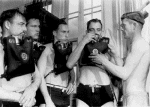 | 39k | The Momsen Lung in use by recruits at the Navy's submarine school. | USN photo courtesy of chinfo.navy.mil. |
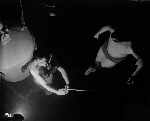 | 83k | Sailors training in submarine escape procedures at the submarine base in Groton, CT during World War II, using the Momsen Lung. | USN photo courtesy of Arkansas Inland Maritime Museum at North Little Rock (aimmatnlr.blogspot.com) |
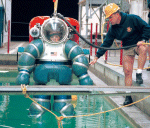 | 392k | Inside the Atmospheric Diving System (ADS 2000) Electrician's Mate Fireman Nathen Kibbler of Killene, Texas, begins a series of endurance tests at San Diego, Calif. 10 March 2000. Navy Divers are evaluating the required endurance standards needed for long-term use of the Atmospheric Diving System (ADS 2000) experimental diving system. | USN photo # N-4309A-008 by Photographer's Mate 2nd Class Aaron Ansarov, courtesy of chinfo.navy.mil. |
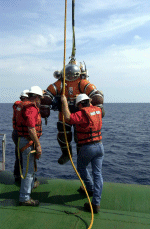 | 226k | The Atmospheric Diving System (ADS 2000) with pilot Andy Brown of Stolz Marine Company is lowered into the water for a dive on the Japanese submarine Akisho, 7 October 2000. Stolz Marine Co. who owns the ADS, is operating with the U.S. Navy Diving System Detachment for the multi-national submarine rescue exercise Pacific Reach 2000. During the exercise the ADS will dive and attach a "haul down" cable to the hatch of a submarine by which the Submarine Rescue Chamber (SRC) will lower itself to the sub and rescue up to six sailors at a time. Also taking part in Pacific Reach is the Japanese Maritime Self-Defense Force, the Republic of Korea Navy and the Republic of Singapore Navy. | USN photo # N-0000X-010 by Senior Chief Photographer's Mate Terry Cosgrove, courtesy of chinfo.navy.mil. |
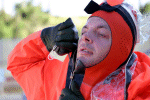 | 81k | A Sailor assigned to the Key West (SSN-722), suits up for training with the MK10 Submarine Escape Immersion Equipment (SEIE) on 12 October 2004 at Pearl Harbor. Several submarines have already installed the new system including Key West, one of 17 attack submarines homeported in Pearl Harbor. This suit allows survivors to escape a disabled submarine at depths down to 600 feet, at a rate of eight or more men per hour. The SEIE is designed to enable a free ascent from a stricken submarine and to provide protection for the submariner on reaching the surface until rescued. The assembly is comprised of a submarine escape and immersion suit, an inner thermal liner and a gas inflated single seat life raft, all contained in an outer protective stowage compartment.
| USN photo # N-0879R-001 by Chief Journalist David Rush, courtesy of news.navy.mil. |
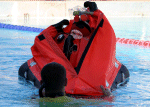 | 230k | A Sailor assigned to the Key West (SSN-722), receives training with the MK10 Submarine Escape Immersion Equipment (SEIE) on 12 October 2004 at Pearl Harbor. | USN photo # N-0879R-007 by Chief Journalist David Rush, courtesy of news.navy.mil. |
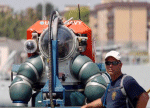 | 28k | U.S. Navy civilian contractor Dave Diepenhorst stands next to the Atmospheric Diving System (ADS 2000) prior to a test dive from Grasp (ARS-51) on June 17, 2005. The (ADS 2000) will participate in rescue scenarios during the NATO submarine escape and rescue exercise Sorbet Royal 2005 running June 17-30 off the coast of Taranto, Italy. The civilian company OceanWorks International, Inc., designed the suit to protect a diver down to 2,000 feet and Sorbet Royal 2005 is the first operational test of the suit since the U.S. Navy acquired it. Unlike other diving suits, this one enables a diver to return to the surface as fast as he needs to without the requirement for decompression | Official DoD Photo provided by
Joint Combat Camera Center, Defense Visual Information Directorate, courtesy of sorbetroyal2005.celex.net. |
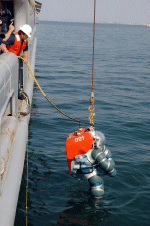 | 519k | U.S. Navy civilian contractor Nate Kibbler, top left, lowers Dave Diepenhorst into the water in an Atmospheric Diving System (ADS) from the salvage ship Grasp (ARS-51) in support of the North Atlantic Treaty Organization (NATO) submarine escape and rescue exercise Sorbet Royal 2005, off Taranto, Italy June 18, 2005. The ADS can assist submarine rescues down to 2000 feet while the diver inside remains at surface pressure. Grasp transported the ADS & Submarine Rescue Chamber along with members of the U.S. Navy's deep submergence unit. | USN photo # N-1464F-005 by Chief Journalist Dave Fliesen, courtesy of chinfo.navy.mil. |
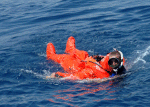 | 285k | A Sailor is rescued by a diver after escaping from the Italian submarine Primo Longobardo in theMK10 Submarine Escape Immersion Equipment (SEIE) suit during the North Atlantic Treaty Organization (NATO) submarine escape and rescue exercise Sorbet Royal 2005 in the Gulf of Taranto, Italy, June 21, 2005. | USN photo # N-1464F-038 by Chief Journalist Dave Fliesen, courtesy of chinfo.navy.mil. |
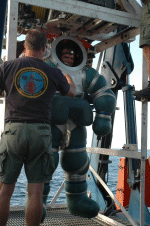 | 286k | Chief Navy Diver Daniel Jackson completes a successful certification dive of the Atmospheric Diving System (ADS 2000) aboard the special mission charter ship M/V Kellie Chouest off the coast of La Jolla, Calif., August 1, 2006. The M/V Kellie Chouest, is a submarine rescue support ship operated by the Navy's Deep Submergence Unit. | USN photo # N-4995K-002 by Mass Communication Specialist Seaman Chelsea Kennedy, courtesy of chinfo.navy.mil. |
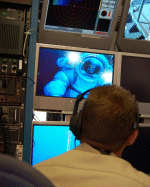 | 123k | Chief Navy Diver Mark Schleef says hello to topside personnel as he takes the new Atmospheric Diving System (ADS 2000) suit for a dive 2,000 feet underwater. A culmination of 11 years of planning, designing and testing by multiple agencies, the Navy successfully certified the use of the new diving suit off the coast of La Jolla, Calif., on August 1, 2006, making the Navy capable of performing dives down to 2,000 feet.
Chief Navy Diver (DSW/SS) Daniel P. Jackson of Navy Reserve Deep Submergence Unit (DSU) was randomly selected to certify the ADS suit for use by the Navy.
"I feel like the luckiest guy in the world," said Jackson. "I am honored and privileged to be the first diver to go down to that depth."
"This is the biggest piece of teamwork that I have ever seen in the Navy," said Cmdr. Keith W. Lehnhardt, the officer in charge of the project.
Lehnhardt said the project was a collaboration of so many different organizations, such as DSU, Submarine Squadron 5 and Diving Systems Support Detachment.
Jackson said, "I was just a guy tied to a rope. It was the Atmospheric Diving System team that made it all possible. They were incredible."
Developed by OceanWorks International from Vancouver, British Columbia, the Hardsuit 2000 was designed to withstand underwater pressure at 2,000 feet. Current models have only been able to go down as far as 1,200 feet.
"The suit worked incredibly," said Jackson. "It did everything it was intended to do. I always heard that around 1,300 feet, the joints of the Hardsuit 2000 would work even better, and it worked exactly the way they said it would."
Meeting the Navy's high safety requirements, the ADS suit was designed and acquired by the Navy to support submarine rescue.
"Its specific purpose is to be part of the advance assessment system during a submarine rescue operation," said Lehnhardt. "The diver in the suit will see what the damage to the sub is and find out where the survivors might be."
"At 2,000 feet, I had topside turn off all the lights, and it was like a star show. The phosphorescence that was naturally in the water and in most of the sea life down there started to glow," Jackson said. "When I started to travel back up, all the lights looked like a shower of stars going down as I was coming up. It was the best ride in the world."
| USN photo # N-7498L-046 by Mass Communication Specialist 3rd Class Mark G. Logico, courtesy of chinfo.navy.mil. |
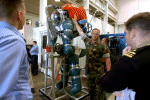 | 71k | Hospital Corpsman 2nd Class Creighton Marshall, a reservist assigned to Deep Submergence Unit (DSU) at Naval Air Station North Island, discusses the different aspects of the Atmospheric Dive Suit (ADS) during DSU's Submarine Rescue Day on May 4, 2007. More than 1,000 visitors were invited to tour the facility, May 4-5, that showcased the personnel, equipment, and capabilities used to perform worldwide submarine rescues. | USN photo # N-4163T-010 by Mass Communication Specialist 2nd Class Stephanie Tigner, courtesy of chinfo.navy.mil. |
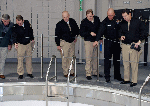 | 129k | Naval Submarine School Command Master Chief Mark Leet gives Vice Adm. John Donnelly, commander, Submarine Force, a tour of the school's new escape trainer on 17 December 2007. The state-of-the-art facility in Momsen Hall, named for Vice Adm. Charles B. Momsen, the developer of a submarine escape breathing apparatus that came to be known as the Momsen Lung, is slated to open for business in spring 2009. Donnelly's visit included discussions with command teams, lunch aboard the fast-attack submarine Providence (SSN-719) and ended with the trainer tour. | USN photo # N-1595E-457 Mass Communication Specialist 1st Class Ira J. Elinson, courtesy of chinfo.navy.mil. |















